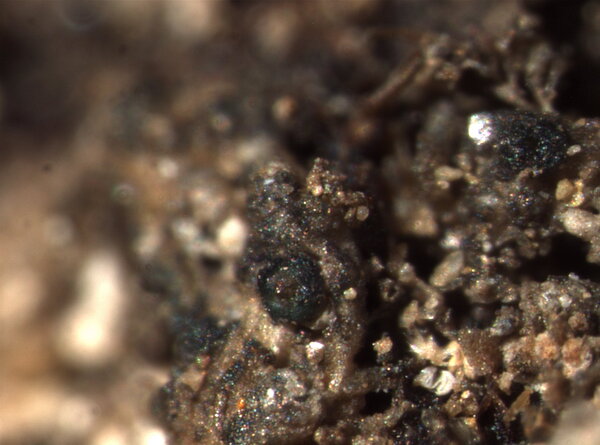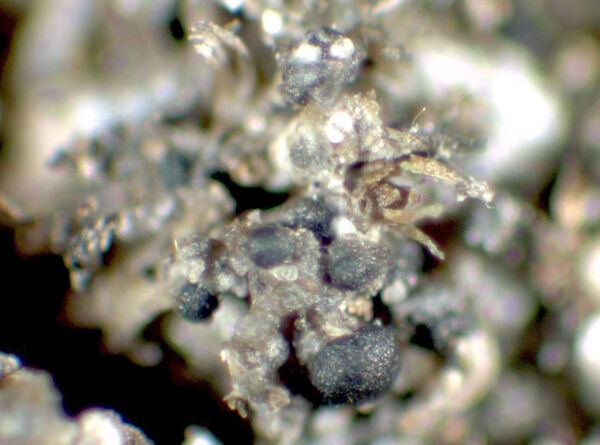Micarea cinerea (Schaer.) Hedl.
Bih. K. Svenska Vetensk.-Akad. Handl., 3, 18: 81, 1892. Basionym: Lecidea cinerea Schaer. - Lich. Helv. Spicil., 3: 156, 1828.
Synonyms: Bacidia cinerea (Schaer.) Trevis.; Biatora delicatula Körb.; Bilimbia cinerea (Schaer.) Körb.; Bilimbia delicatula (Körb.) Körb.; Hastifera tenuispora D. Hawksw. & Poelt; Lecidea sphaeroides var. albella Schaer.
Distribution: N - Frl (Tretiach & Hafellner 2000), TAA (Nimis & al. 2015, Brackel 2016, Nascimbene & al. 2022), Lomb, Piem, Lig (Giordani & al. 2002).
Description: Thallus crustose, endosubstratic or thinly episubstratic, when well-developed consisting of scattered to contiguous, greenish white to blue-grey, convex to subglobose, up to 0.3 mm wide areoles. Apothecia micareoid, round, sessile, not constricted at base, up to 0.7 mm across, sometimes confluent into tuberculate, up to 1.3 µm wide aggregates, with a whitish, cream, bluish-white, greyish-straw, brownish-grey to lead, mostly piebald disc and usually with a slightly paler (especially when immature), almost whitish margin. Proper exciple poorly evident, developed only in young apothecia, colourless, of 2-2.5 μm thick, paraphysis-like hyphae; epithecium greenish, poorly differentiated from the hymenium; hymenium colourless to olive-green or blue-green in upper part, 50-70 μm high, the pigmented parts K- and N+ red; paraphyses coherent, branched and anastomosing, 1-1.5 μm thick, the apical cells to 2.5 μm wide; hypothecium colourless. Asci 8-spored, clavate to cylindrical-clavate; in K/I with a blue outer layer and apical dome and unstained wall, the dome with an apical cushion, 45-65 x 12-18 μm. Ascospores (3-)5-7-septate, hyaline, fusiform-elongate to broadly worm-like, thin-walled, (19-)23-36(-40) x (3.5-)4-6 μm. Pycnidia prominent, wart-like, basally immersed in the thallus, paler around the depressed, crater-like ostiolar region, the wall K-. Macroconidia 9-17-septate, flexuous, filiform, (45-)50-110 x 1-1.2 μm; microconidia narrowly fusiform, to 5 μm long. Photobiont micareoid, thin-walled, the cells 4-8 μm wide. Spot tests: thallus, apothecial and pycnidial sections K-, C+ red, KC+ red, P- (reactions best visible under the microscope). Chemistry: gyrophoric acid. Note: a cool-temperate to probably circumboreal-montane species found on the acid bark of deciduous and coniferous trees and on epiphytic bryophytes, in humid montane to subalpine forests, more rarely on lignum of fallen, decorticated trunks and on siliceous pebbles. The Italian distribution seems to be restricted to the Alps.
Growth form: Crustose
Substrata: bark and lignum
Photobiont: green algae other than Trentepohlia
Reproductive strategy: mainly sexual
Most common in areas with a humid-warm climate (e.g. most of Tyrrenian Italy)
Commonnes-rarity: (info)
Alpine belt: absent
Subalpine belt: rather rare
Oromediterranean belt: absent
Montane belt: rare
Submediterranean belt: absent
Padanian area: absent
Humid submediterranean belt: absent
Humid mediterranean belt: absent
Dry mediterranean belt: absent

Predictive model
Herbarium samples
Growth form: Crustose
Substrata: bark and lignum
Photobiont: green algae other than Trentepohlia
Reproductive strategy: mainly sexual
Most common in areas with a humid-warm climate (e.g. most of Tyrrenian Italy)
Commonnes-rarity: (info)
Alpine belt: absent
Subalpine belt: rather rare
Oromediterranean belt: absent
Montane belt: rare
Submediterranean belt: absent
Padanian area: absent
Humid submediterranean belt: absent
Humid mediterranean belt: absent
Dry mediterranean belt: absent

Predictive model
| Herbarium samples |
 INDEX FUNGORUM
INDEX FUNGORUM
 GBIF
GBIF
 DOLICHENS
DOLICHENS






